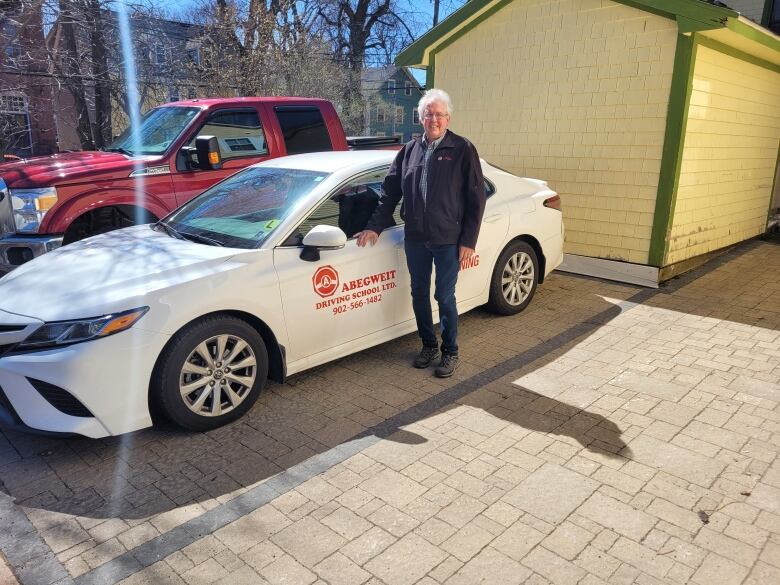9 ways to save money while driving
Gas prices have reached record highs and people are looking for ways to save

If you've filled up a gas-powered vehicle at the pump lately, you might be thinking about ways to get the most out of that pricey tank of fuel.
As gas prices and inflation continue to soar on P.E.I., CBC News sought advice from P.E.I.'s Director of Sustainability Derek Ellis, CAA Atlantic's Steve Olmsteadand driving instructor Joe Byrne about how tosavemoney whiledriving.
1. Slow down
For those who want or need to continue driving, there are plenty of ways to save money that can add up one ofthe most importantbeing to slow down.
Driving no faster than the posted speed limit, which on P.E.I. is usually 80 to 90 km/h, will save on fuel, our experts said.
"Anything below that, where we can, is a great idea in terms of saving fuel," Olmstead said.

2. Accelerate gradually
Accelerating gradually from a stop rather than punching the pedal isalso a big gas-saver. In fact, it'snumber oneon the federal government's list of tips of fuel-efficient driving techniques.
"To be as fuel-efficient as possible, take fiveseconds to accelerate your vehicle up to 20 kilometres per hour from a stop. Imagine an open cup of coffee on the dashboard. Don't spill it!" the site says.
If your car is newer and displays a fuel economy readout as you drive, Ellis said you'll soon see how much gas you're wasting on accelerating quickly. He uses this feature in his vehicle to "play a game where you're keepingthat number, that'smeasured in litres per 100 kilometres,as low as possible while you drive."
Olmstead suggests not only startingout slower from a stopbut also coasting to stops when it's safe.

3. Tire inflation
Having the right amount of air in your car's tires can beanother big fuel-saver. Find the right number for your car's tires posted on your car's door or in your owner's manual, and add air at a gas station.
Invest in a manual tire pressure gauge and check tires at least with the change of seasons, Ellis said. Byrne also does a visual inspection of his tires daily.
Remember to check tire pressure when tires are cooler, at the beginning of an outing.
4. Maintain your vehicle
Check and maintain fluids like coolant and oil in your car, and maintain the engine, battery andtransmission for optimal fuel consumption, Byrne said.
Switching winter tires out for spring ones at the right time will improve fuel consumption by reducing rolling resistance, Olmstead said.
Have your car inspected regularly by a mechanic to make sure it is running smoothly, he added.P.E.I. mandates annual inspections for vehicles, sothat garage visit is already built in.
5. Stop idling
Many newer vehicles will shut off automatically when you're stopped for any period of time, say at a light or in a drive-thru, Ellis points out.

"Anytime you're stopping to drop someone off or pick someoneup I think you should turn off the engine recognizing thatifthe engine is on in an internal combustion vehicle and you're not moving, your fuel efficiency, your miles per gallon,is zero ... as bad as it possibly could be," Ellis said.
Byrne's rule is if you have to wait more than 10 seconds, shut the car off and you will save money. Watch the lights and you will see when you need to turn your car back on, he said however, your car needs to be well-maintainedto start on cue like this.
6. Reduce load and drag
Takethose golf clubs orbags of saltout of your trunk, and remove roof and bike racks that increase drag.
It might be a little inconvenient but pulling them around costs money.
7.Plan your trip
Trip planning is important to reduce gas: if you have several chores, Byrne said, make one trip with multiple stops rather than several trips with one stop each.
Also, plan your route to reduce the amount of driving, thinking about traffic patterns during certain times of day.

8. Change vehicles
Ellis strongly suggests people who can afford it move to an electric or hybrid electric-and-gas vehicle to save money on fuel.
"You're looking at 60 to 80 per cent savings on fuel, your electricity versus gas," he said.

He acknowledges there is a shortage of electric vehicles in the market right now, with waits of several months or more for some models due to COVID-19 manufacturing slowdowns and gas prices on P.E.I. continuing to drive strong demand.
There's also higher up-front cost of about $45,000 (and up)for a new electric vehicle.
P.E.I. offers a $5,000 rebate on new or used electric vehicles, and $2,500 off plug-in hybrids and provides a freeLevel 2 charger. The federal government also provides an additional $5,000 rebate for any new electric vehicle. About 400 Islanders have used the incentive in the past year, Ellis said.
With electric and hybrid vehicles still more expensive than traditional gas-powered vehicles, you'll need more money up front, but rising gas prices will now see thatcost pay off sooner. Ellis said he expects the price gap to narrowand be eliminated before the end of this decade.
"At that point, I thinkit'll be a no-brainerfor the majority of Islanders to make theswitch," Ellis said.
New programs to help more P.E.I. businesses install electric vehicle chargers are in the works, he added.
CAAalso promotes electric cars, since the organization's members are interested in more sustainabletransportation, Olmstead said. The associationoffers test drives for members in electric vehicles.
9. Drive less
"If you dramatically want to reduce your fuel costs, driving less often will really be impactful," says Ellis, who is in charge of P.E.I. reaching its ambitious net-zero goals.

"Using bikes or walking is an obvious answer, although not always an option for folks in rural areas or in the suburbs."
Toencourage Islanders to drive less,government has been spendingmoney in the last few years onactive transportation it's in year three of a five-year plan to spend $5 million a year on active transportation projects and recently expanded rural transit on P.E.I.
Byrne, who has been a driving instructor for 12 years, says making more deliberate decisions about whether to drive is a big way to save. He notes people in many places on P.E.I. still can't live easily without a car but the development of cycling lanes has been a step in the right direction.












_(720p).jpg)


 OFFICIAL HD MUSIC VIDEO.jpg)
.jpg)



























































































